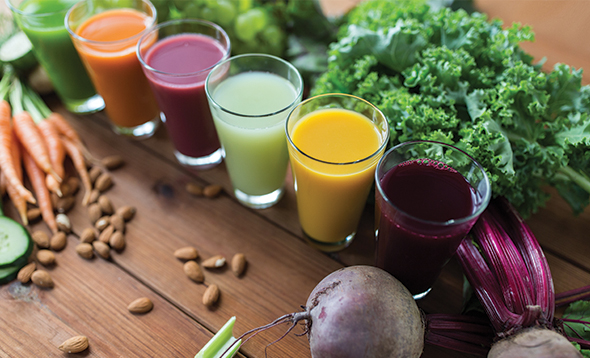That organic living is a conscious health choice
How to Get the Most Out of Your Juice
Fresh juices are an ideal way to get concentrated nutrients and phytochemicals straight from whole natural foods, rather than from powders or pills.
But not all juices are created equal. With the vast libraries of online recipes and extensive menus at juice bars and cafes, it’s hard to choose the best ones for your body and it’s easy to make a nutritional misstep. Here are a few simple tips to keep you on a healthy track:
1. Favour vegetables.
The days of fruit-only and vegetable-only juices are over. Fruit and vegetable blended juices are now a standard fare at most cafes and juice bars. However, while the number of fruit and vegetable ingredients might appear balanced as listed on a menu, the recipes often aren’t so.
To satisfy consumer demand for sweetness, juiceries quietly and heavily rely on fruits to boost the sweetness of their drinks. Do they please public palates? Yes. Do they support your wellness goals? Perhaps not. Fruits are undoubtedly nutritious, but when five to six servings are consumed in a concentrated form at a time, they can complicate calorie and blood sugar control. So, double check the proportion of fruits in your juices. When possible, customise. Request that your juice is made mostly with vegetables and just one or two servings of fruit for a touch of sweetness.
2. Go green – but not every time
Green juices usually take the centre stage in any juicing conversation. Why? The primary ingredients – mostly green vegetables and a fruit or two - are relatively low in calories but loaded with valuable plant-based minerals such as iron, calcium, and magnesium, and vitamins C, E, K, and folic acid. Green juices are also rich in sulphur compounds, which support liver function. Packed with chlorophyll, the emerald-hued pigment that literally clears toxins before they reach the bloodstream, many regard nutrient-dense green juices as liquid gold.
With this long list of perks, it’s tempting to always and only reach for green juices. Don’t do it! You’ll miss out on the full range of nutrients and phytochemicals from the other colourful produce at the market - red lycopene from tomatoes, orange carotenoids from carrots and purple anthocyanins from grapes, just to name a few. Sip the rainbow and you’ll steep your body in all that Mother Nature has to offer.
3. Opt for organic
Juicing extracts and concentrates the nutrients from multiple servings of fruit or vegetables into a beverage form. When conventional – rather than organic – produce is used, your drink can become a concentrated cocktail of fertilisers, pesticides and herbicides. These compounds are understood to cause oxidative cellular damage in the human body. Yes, your juice will offer antioxidants that counteract free radicals. However, ideally these should be used to benefit your system, rather than cancel out the negative effects of the harmful chemicals that made it into your glass.
4. Wash well
Just as you would prior to eating any fresh produce, wash well before juicing. Your fruits and vegetables take quite a long journey to get from the farm to your household. And they invariably collect unwanted souvenirs – chemicals, dirt, bacteria, and debris - on their exterior along the way. Studies suggest that a thorough wash with water – minding the nooks and crannies near the stems - removes 98 per cent of bacteria and superficial particles. However, ridding the protective waxy layer on some produce - both organic and conventional –requires additional effort. Store-bought washing solutions are available, but soaking your produce in a bath with a natural agent such as baking soda, lemon or vinegar, and gently scrubbing them after can also do the trick.
5. Reach for ripe fruits
Juicing is a convenient way to ‘use up’ fruits and vegetables that are less aesthetically appealing – those that have an exterior blemish or have been bruised en route to the market. There’s no harm in this at all.
However, to cut costs, many juice companies often use produce that are well past their prime. Consumers end up paying for this cost – nutritionally. Using fresh fruits and vegetables at the peak of their ripeness guarantees the highest concentration of vitamins, minerals, and phytochemicals. After this point, these valuable compounds will progressively decline. So, select the best produce for your homemade juices and make sure your favorite juice cafe does the same as well.
6. Opt for slow cold-pressed juice
Fresh fruits and vegetables are packed with beneficial vitamins, minerals, phytochemicals, antioxidants and enzymes. High temperatures can degrade or completely deactivate these live organic compounds. The engines of electric juicing equipment, like all machines, generate heat. As the name suggests, a slow cold-pressed juice is made using an appliance that uses pressure to extract juice from produce, but operates more slowly so that it remains cool. This preserves the delicate nutrients and ensures they reach your system more effectively.
7. Don’t wait
Drink your freshly pressed juice within 20 to 30 minutes – or better yet, right away if possible. The nutrients – especially antioxidants, phytochemicals and enzymes - are fragile and begin to dissipate or decline over time with exposure to light, air or heat.
If you can’t or don’t intend to drink your juice immediately, set it in the refrigerator. The cool environment will protect the juice against bacteria. Many pre-bottled juice companies claim up to 72 hours shelf-stability in the fridge. But these estimates assume industrial-grade machinery, observance of high sanitation standards and pasteurisation.
Play it safe. Toss your homemade juice after 12 hours. To preserve freshness and prevent spoilage, store your juice in wide-mouth glass jars. Plastics can leach into liquids and narrow mouth bottles are difficult to clean. Store a single serving with as little air as possible and add a twist of lemon or lime as a natural preservative.
8. Clean up
Prepping juices isn’t the tidiest of tasks, but it is extremely important to make sure your equipment is properly cleaned between uses. Many new juicers are designed with an ease of cleaning in mind. If removable parts aren’t dishwasher safe, wash well with warm soapy water. Use a dish brush or toothbrush to clean the mesh screen that filters the peels and fibre, as tiny particles often linger. Likewise, be sure to wipe stray juice droplets or splashes from the exterior. Allow all parts of the juicer to air dry completely before reassembling. Any moisture or residue can quickly become a breeding ground for mould and pathogens.
9. Mind your portions
It’s easy to underestimate or completely overlook the calorie content of juices. The juice of about five medium-sized oranges easily fills a 240ml glass and contains five tablespoons of sugar – equivalent to the sugar content in 100g of ice cream or a 40g Snickers bar!
If we were to eat the whole oranges, we’d likely feel quite full. However it’s not uncommon to drink a glass of orange juice – or two - alongside a full breakfast meal. Likewise, unbeknownst to many, there are often more calories in a single serving of vegetable juice than in a large undressed vegetable salad. And often the portions served by juiceries are double, triple or even quadruple the volume of a standard serving. So, to keep your daily calorie count - and your waistline - in check, drink juices in moderation. Enjoy a glass of juice as a between-meal snack or reduce the size of your main meal to offset the calories from your favourite juice.
10. Don’t forget to eat
If juices are the only way you can tolerate a fruit or vegetable, then – by all means – drink up! Fluid form is definitely better than none at all. However, it’s important to remember to eat whole produce, too. Juicing extracts the juice but removes most or all of the external peel and the fleshy internal pulp. These discarded components contain antioxidant-rich phytochemicals as well as fibre to support digestion and stabilise blood sugar levels. Grab a side salad or drop an apple in your purse or briefcase for a mid day snack and take advantage of the complete nutritional package that Mother Nature has to offer. You’ll enjoy a more textured sensory experience, too.


























_1672804154.jpg)

_1611290459.jpg)